Feb 25, 2012
Ottmar Mergenthaler’s Bride
Casting and Composition – Linotype: The Film
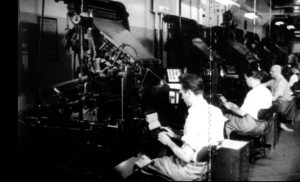
According to the filmmakers Linotype: The Film started out as a story about a machine but eventually became a portrait of a machine’s admirers. A linotype machine is a heavy but delicate machine that allows an operator to use a keyboard to string together moulds of letterforms. Hot metal is ejected into the moulds to create lines of type. When cool these are removed and stacked into matrices ready for inking and printing.
The Linotype machine speeded up the process of manual typesetting by a factor of six, drastically reducing the cost of printing. Before Otto Mergenthaler, a German watchmaker, invented the Linotype in 1870, newspapers were no more than eight pages long, books were prohibitively expensive for most people and public libraries were few. Mergenthaler’s Linotype machine enabled exponential growth of the reading public.
The process starts with a piece of paper held in place in front of an operator who types the text on the paper onto a keyboard. Each keystroke releases a negative imprint of a letterform from a magazine of matrices. The letterforms align as the operator types and wedge-like separators are dropped from a spaceband box and lightly slid into spaces between words.
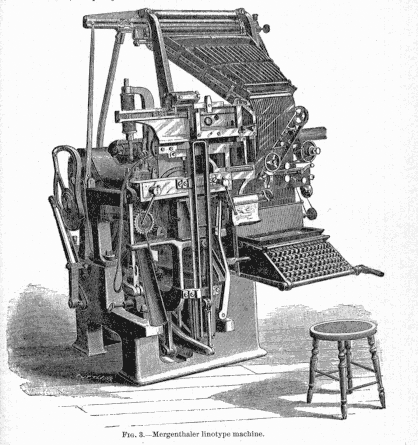
When a line of type has been assembled the row of matrices moves up the ‘first elevator’ to a justification vise where, in order to justify the line, the wedge-shaped spacebands are expanded by the action of a spring-loaded ram that raises the tails, or bottoms, of the spacebands.
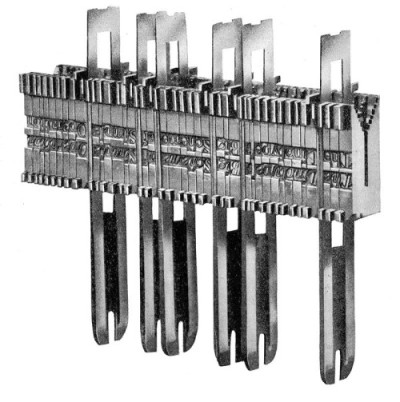
An amalgam of lead, tin and brass, bubbles away at 350 degrees ready to be squirted into the matrices by the action of a piston in the pot that holds the molten metal. Operators talk of their first squirt. If the line being cut is too loose the hot metal can be ejected on to the operator. The slug of metal that the line of matrices forms is then rotated 280 degrees, ejected by a rod and trimmed by a set of knives.
The function that made the machine truly and visibly efficient comes next when the matrices and spacebands, having discharged the hardened metal lines of type, are recycled back to their original positions by the action of a grooved distributor rod that acts like a key on the serrations of the matrices, dropping one when the grooves match the serrations.
It’s unlikely that Marcel Duchamp ever operated a Linotype machine but he probably saw one.
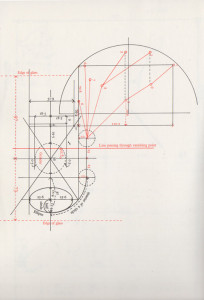
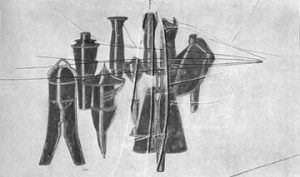
Here is Richard Hamilton describing the Duchamp’s Large Glass:
“Water falls, the mill wheel begins to spin, and starts the slow reciprocations of the chariot, we overhear its chanted litanies cast into malic forms. We become aware of the moulded gas seeping towards the elaborate conditioning which will prepare it for its final orgiastic splashing and observe with wonder the beauty of its auras. The juices flow to the Bride, messages are transmitted from pools of random possibilities, the throbbing energy of a robotic world strains to create. The Bride stripped bare by her Bachelors, even rumbles into it’s fantastic splendour.”3
As much as Duchamp, Hamilton deployed the working methods of engineers. From the exacting perspectival demands of the Occultist Charts and Witnesses, we get to the pure but pragmatic geometry of Hamilton’s Pirelli tires.
But the Large Glass is a hilarious and impossible contraption. A mechanical hive-bound queen bee. An elegant and mysterious engine. A crude peep-show. The bachelors (many) are forever separated from the bride (one) by a quarter inch gap between the two sheets of glass. Duchamp’s notes attest to the fact that there is no implied transfer of physical energy or substance between the bachelors and the bride they are adoring. All is imagined.
What transfer of energy takes place between the printed word and the thought it produces in the mind of a reader?
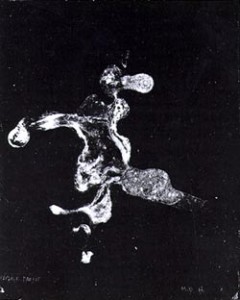
The Linotype operators interviewed in the film had developed strong attachments to the device. The machine was not easy to operate and maintain, but when handled well performed brilliantly. A claim is made about a man rapidly tapping away on the keyboard, that this is the fastest operator alive. A lean man in his eighties, he plays the machine like a hurried concert pianist. He was, like many linotype operators, deaf.
Other characters in the film, some who collected Linotype machines in order to save the parts, some who preserved or maintained a working machine, spoke of their respect and near adulation of the machine. For many of the machines still in existence its a short trip to the scrap yard. One owner has no choice but to bring his beloved machine to the scrap yard. He has to turn his back on the destruction that the camera facing him sees. Behind him mechanical claws grip the machine and repeatedly bounce it off the ground until it breaks into bits.
In 1927 an accident completed Duchamp’s Large Glass. In transit from an exhibition at the Brooklyn Museum the Large Glass cracked. Duchamp declared the piece at last ‘unfinished’.
References
- “Typesetting”, Salesian Vocational and Technical Schools, Italy. [↩]
- The Bride Stripped Bare by Her Bachelors, Even: A Typographic Version By Richard Hamilton of Marcel Duchamp’s Green Box, translated by George Heard Hamilton, Percy Lund, Humphries and Co. Ltd. London and Bradford and George Whittenborn Inc, New York, 1960 [↩]
- The Bride Stripped Bare by Her Bachelors, Even; Hamilton & Hamilton [↩]